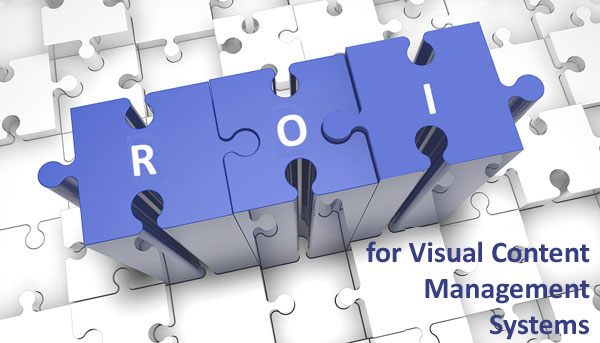In the final article in this series, we discuss the ROI of implementing a visual content management system.
Using a Visual Content Management system saves organisations time and money. The savings come from reduced labour costs and reduced time spent on searching for visuals and repurposing content. To understand just how much value these systems can bring, businesses will need to do a little number crunching to determine its ROI.
In this article, we’ll focus on the ROI of not having to search as much for images and other visual content. Before we dive in, remember a figure from a previous article – an average of 37 minutes or 8% of the working day is wasted on searching for information. There’s no doubt that content management drastically reduces this figure.
You can also calculate the ROI based on numerous other criteria such as savings on licensing fees and reduced costs on software and hardware upgrades.
Calculating ROI

Nevertheless, calculating an ROI can help supporters make the case for using a content management system for their company’s social media endeavours. Here’s how you can work out the cost savings and the ROI:
To start off, we need a figure for your cost to license one, let’s say it is $4,000 pa.
Then we need to know something about the employees who will use the syststem and the hours they currently waste searching for visual content. For this exercise we will assume there are three employees on $40,000 per annum who waste 2 hours each per week.
Step One: Calculate wasted hours per year.
3 people x 2 wasted hours for 52 weeks = 312 wasted hours.
Step Two: Calculate cost of those wasted hours.
Average salary=$40,000 for 1,820 hours per annum = a rate of $22 per hour.
Cost of wasted hours= 312 x 22= $6,864
So every year, this hypothetical company wastes $6,864 searching for images etc.
Step Three: Calculate net savings.
Now let’s work on the assumption that on average solution slashes the time to find rich media content by 75% and factor that in to find out how much money the company has saved.
$6,864 x 75%= $5,148. So overall in this first year, it saves $1,148 ($5,148 – $4,000).
Step Four: Calculate ROI percentage.
Now that we have a net figure for the savings, the next step is to turn it into a percentage for ROI, which is done like this:
(Savings – Cost)/Cost = ROI
($5,148 – $4,000)/$4,000=28%
Increased ROI over Time

However, do bear in mind that when staff have been fully trained to use Visual Content Management System for social media, there is an excellent work flow and the system is well maintained, you will see increased returns over time.
What this figure does not represent however is the money that is saved by having the ability to reuse and repurpose visual content – creating content is expensive and the savings for this could easily out way the savings in wasted hours.
MavSocial is an industry leader in visual content management for social media. If you would like to learn more about how a VCM can help your social marketing, request a demo of our platform. You will soon discover how you can save time and money.
To see the second article on Best Practices to Ensure Visual Content Management Success click here.

